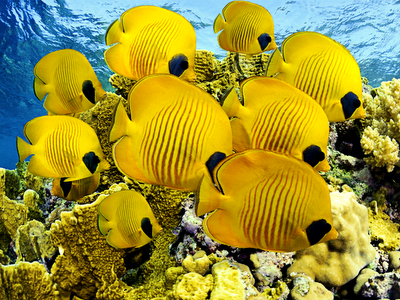The Life of Animals | Butterfly fish | Mostly Butterflyfish range from 12 to 22 centimetres (4.7 to 8.7 in) in length. The largest species, the lined butterflyfish and the saddle butterflyfish, C. ephippium, grow to 30 centimetres (12 in). The common name references the brightly colored and strikingly patterned bodies of many species, bearing shades of black, white, blue, red, orange and yellow. Other species are dull in color. Butterflyfish have uninterrupted dorsal fins with tail fins That may be rounded or truncated, but are never forked.
Generally diurnal and frequenting waters of less than 18 meters (59 ft) (though some species descend to 180 meters (590 ft)), butterflyfish stick to particular home ranges. The corallivores are ESPECIALLY territorial, forming mated pairs and staking claim to a specific coral heads. Contrastingly, the zooplankton feeders form large conspecific groups. By night butterflyfish hide in reef crevices exhibit markedly different coloration. Their coloration also makes butterflyfish popular aquarium fish. However, most species feed on coral polyps and sea anemones.
The subfamily name Chaetodontinae is a little-used leftover from the period of the Pomacanthidae and Chaetodontidae Pls were the resource persons united under the latter name as a single family. Hence, Chaetodontinae is today Considered a junior Synonym of Chaetodontidae. In any case, one lineage of Chaetodontidae (in the modern sense) contains the "typical" butterflyfishes around Chaetodon, while the other unites the bannerfish and coralfish genera. The fossil record of this group is marginal.
A crude molecular clock in combination with the evidence given by Pygaeus allows to place the initial split the between the two main lineages to the mid-late Eocene, and together with the Few other fossils it allows to deduce That Probably most distinct were the resource persons living genera by the end of the Paleogene 23





No comments:
Post a Comment